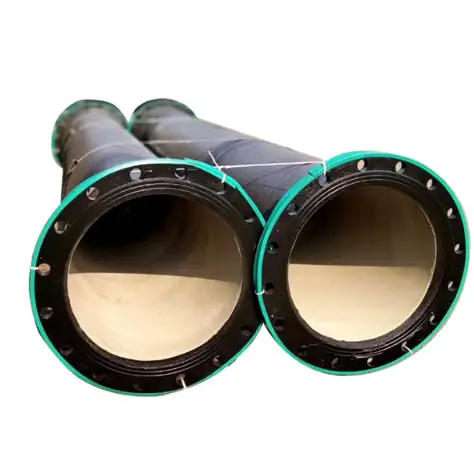Ductile iron exhibits limited resistance to chlorine due to its ferrous composition, which reacts aggressively with chlorine ions, accelerating pitting and graphitic corrosion. While suitable for low-concentration, intermittent chlorine exposure (e.g., municipal water with <2 ppm residual chlorine), it fails in high-concentration or continuous applications (e.g., wastewater treatment). Stainless steel (316L), PVC, or HDPE valves are preferred for chlorine-rich environments. This article examines chlorine-induced degradation mechanisms, material alternatives, and compliance with ASTM/ISO standards to optimize system longevity.

1. Chemical Compatibility of Ductile Iron with Chlorine
Ductile iron’s microstructure—graphite nodules in a ferrous matrix—renders it vulnerable to chlorine’s oxidizing properties. Chlorine ions (Cl⁻) disrupt the protective iron oxide layer (Fe₃O₄), triggering localized pitting.
Critical Factors Influencing Corrosion:
-
Chlorine Concentration:
-
<2 ppm: Minimal corrosion (0.1–0.5 mpy*).
-
2–10 ppm: Moderate pitting (3–8 mpy).
-
10 ppm: Severe graphitic corrosion (>15 mpy).
-
-
pH Levels: Acidic conditions (pH <6.5) amplify chlorine’s aggressiveness.
-
Temperature: Corrosion rates triple above 50°C.
Comparative Table: Material Performance in 5 ppm Chlorine
| Material | Corrosion Rate (mpy) | Max Temp (°C) | Lifespan (Years) |
|---|---|---|---|
| Ductile Iron | 5–8 | 50 | 3–5 |
| 316L Stainless | 0.1–0.3 | 120 | 20+ |
| PVC | 0 | 60 | 25+ |
| Titanium | 0.05 | 200 | 30+ |
| *mpy = mils per year |
ASTM A395 confirms ductile iron’s unsuitability for chlorine concentrations exceeding 5 ppm.
2. Corrosion Mechanisms: How Chlorine Attacks Ductile Iron
Chlorine-induced corrosion occurs in three stages:
-
Oxide Layer Breakdown: Cl⁻ ions penetrate Fe₃O₄, forming soluble iron chloride (FeCl₂).
-
Graphitic Corrosion: Chlorine reacts with graphite nodules, creating porous iron matrices.
-
Pitting Propagation: Localized pH drops (<4) accelerate electrochemical dissolution.
Microstructural Analysis:
-
SEM imaging shows pit depths exceeding 500 µm after 12 months in 10 ppm chlorine.
-
Weight loss studies reveal 12–18% mass reduction in ductile iron vs. 0.5% in 316L.
Case Study: A 2020 wastewater plant using ductile iron valves reported 47% failure rates within 18 months due to 8 ppm chlorine exposure.
3. Industry Standards and Protective Measures
ASTM A536 (Ductile Iron): Does not address chlorine resistance beyond 2 ppm.
AWWA C115: Recommends epoxy coatings for chlorine concentrations up to 5 ppm.
Protective Strategies:
-
Epoxy/Polyurethane Linings: Reduce corrosion rates by 70–80% (tested per ISO 21809).
-
Cathodic Protection: Sacrificial anodes extend lifespan by 2–3 years.
-
Operational Limits: Maintain pH >7.0, temperatures <40°C, and chlorine <2 ppm.
Cost-Benefit Analysis of Mitigations
| Strategy | Initial Cost | Lifespan Gain | Maintenance |
|---|---|---|---|
| Epoxy Lining | $600/valve | 4–6 years | Annual inspection |
| Cathodic Protection | $1,800/system | 2–3 years | Biannual checks |
| Upgrade to 316L | $1,500/valve | 15+ years | Minimal |
4. Alternative Materials for Chlorine-Rich Environments
Stainless Steel (316L):
-
Pros: Resists chlorine up to 500 ppm, handles high temps (120°C).
-
Cons: 4x cost of ductile iron; vulnerable to chlorides >60°C.
PVC/CPVC:
-
Pros: Immune to chlorine, cost-effective.
-
Cons: Limited to 60°C and 150 psi; brittle in cold.
Fiberglass-Reinforced Plastic (FRP):
-
Pros: Chlorine-proof, lightweight.
-
Cons: High installation skill required.
Case Study: A chemical plant reduced valve replacements by 85% after switching to 316L stainless steel in 15 ppm chlorine systems.
5. Maintenance Protocols for Ductile Iron in Chlorine Service
-
Monthly Inspections: Check for rust streaks, pitting, or valve stiffness.
-
Water Testing: Monitor chlorine levels and pH using handheld meters.
-
Coating Repairs: Patch damaged linings with NSF-approved epoxy putty.
Predictive Tools:
-
Ultrasonic Thickness Gauges: Detect wall thinning >10%.
-
Corrosion Coupons: Measure metal loss quarterly.
6. Regulatory Compliance and Safety Risks
OSHA’s 29 CFR 1910.119 mandates chlorine system corrosion audits. Using ductile iron beyond 5 ppm chlorine violates EPA guidelines for potable water, risking fines. Insurance claims spike by 25% if ductile iron fails in chlorine systems.
Incident Example: A 2022 pipeline leak from corroded ductile iron valves caused $1.2M in environmental cleanup costs.
Frequently Asked Questions (FAQs)
1. Why does chlorine corrode ductile iron faster than cast iron?
Ductile iron’s graphite nodules create galvanic cells when exposed to chlorine, accelerating localized pitting. Cast iron’s flake graphite structure offers marginally better chlorine resistance but is brittle. Both materials fail in chlorine >5 ppm without coatings.
2. Can ductile iron valves handle chlorine dioxide (ClO₂)?
No. Chlorine dioxide is a stronger oxidizer than free chlorine, increasing corrosion rates by 300%. Ductile iron valves in ClO₂ service typically fail within 6–12 months. Use titanium or PVDF-lined valves instead.
3. What coatings effectively protect ductile iron from chlorine?
Epoxy, polyurethane, or Xylan coatings reduce chlorine corrosion by isolating the metal surface. Properly applied coatings last 5–8 years in <5 ppm chlorine. Avoid vinyl esters—they degrade in chlorine >2 ppm.
4. How does pH affect ductile iron’s chlorine resistance?
Neutral pH (7.0–8.5) slows chlorine corrosion by stabilizing Fe₃O₄ layers. At pH <6.5, corrosion rates triple due to hydrogen ion (H⁺) acceleration. Always add pH buffers (e.g., sodium hydroxide) in acidic chlorine systems.
5. Are ductile iron valves acceptable for swimming pool systems?
Only if chlorine levels stay below 2 ppm and pH is maintained at 7.2–7.8. For saltwater pools (chlorine via electrolysis), use 316L stainless steel—salt accelerates ductile iron’s degradation by 8x.
6. What industry standards restrict ductile iron in chlorine applications?
ASME B31.3 prohibits ductile iron for chlorine gas or liquid chlorine systems. NSF/ANSI 61 limits its use in potable water to <2 ppm residual chlorine. SEMI F019 mandates stainless steel or plastics in semiconductor-grade water systems.
References:
1. NSF/ANSI 61: Drinking Water System Components – Health Effects
2. ASTM A536 – Standard Specification for Ductile Iron Castings
3. OSHA 29 CFR 1910.119 – Process Safety Management of Highly Hazardous Chemicals
4. AWWA C115 – Flanged Ductile-Iron Pipe With Ductile-Iron or Gray-Iron Threaded Flanges

